
| King of Sweden | |
|---|---|
| Sveriges konung | |
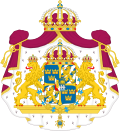 | |
| Incumbent | |
 | |
| Carl XVI Gustaf since 15 September 1973 | |
| Details | |
| Style | His Majesty |
| Heir apparent | Victoria |
| First monarch | Eric the Victorious |
| Formation | 970; 1054 years ago (970) |
| Residence | Stockholm Palace Drottningholm Palace |
| Appointer | Elective monarchy (970–1544) Hereditary monarchy (since 1544) |
| Website | www |
Text
Source for entries:
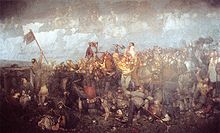
The territorial unification of Sweden is generally dated to about AD 1000–1250, starting later than those of Denmark and Norway and progressing more slowly.[1] Due to a scarcity of sources, rulers during this period, as well as under preceding centuries, are relatively poorly attested.[1] There were organized political structures in Sweden before the medieval kingdom was unified; based on archaelogical evidence, early tribal societies are believed to have transitioned into organized chiefdoms in the first few centuries AD, perhaps spurred by contacts with the Roman Empire and the rest of Europe.[2] Based on later accounts, and of what is known of other Germanic peoples, such chiefdoms may have been led by chieftains or petty kings referred to as reiks ("leader of men"), elected by an aristocratic tribal council.[3] In the period AD 500–800, Scandinavian societies began adopting cultural elements from the newly established Germanic kingdoms in Europe, transitioning further into petty kingdoms.[4]
Archaeological evidence suggests that were numerous petty kingdoms throughout modern-day Sweden. Foreign sources and later native sources describe the later medieval kingdom as being composed of two main regions: Svealand (particularly around Lake Mälaren) and Götaland. Sources from as early as the Roman author Tacitus (c. 56–126) mention two main peoples or tribes in modern Sweden: the Svear (Swedes) and Götar (Geats); the Svear are mentioned in more foreign sources than the Götar, credited with military activities at sea. Because of this frequent association, the term could possibly indicate a social group or function, rather than an ethnicity.[5] The securely attested Swedish rulers in the Viking Age, predecessors of the later line of Swedish kings, ruled from the religious and political center of Old Uppsala; though its history before the Viking Age is poorly attested it is probable that Old Uppsala had been a political and religious center since the Migration Period.[6] Old Uppsala was home to the kings of the Svear; there is no secure historical evidence of any similar pre-Christian kingship among the Götar.[7]

The earliest historically attested Swedish rulers are 9th-century petty kings from the Vita Ansgarii, an account written c. 870 by Rimbert partly concerning Saint Ansgar's visit to Svealand.[8][9] Some kings of Old Uppsala are also mentioned in later Icelandic texts and sagas.[7] These later texts, though notable as works of literature, are generally disregarded by modern scholars as sources for historical events; though it is possible that some truth remains in some of the stories, it is regarded to be overshadowed and lost among inventions and myths.[9][10] The line of legendary Swedish kings from Icelandic tradition, called sagokungar ("fairy tale kings") in Swedish, are not generally treated as historical figures; though some may be based on actual chieftains or petty kings, the poor source material, written down centuries after they are said to have lived, make them impossible to study and approach as anything other than mythical figures.[9] Some later king-lists deliberately extended the sequence of kings for nationalistic purposes, such as Johannes Magnus's Historia de omnibus Gothorum Sueonumque regibus (1554); supposed ancient kings mentioned in such sources are clearly fictional.[9]
The petty kingdoms eventually gave rise to more complex political structures and what is today considered the beginning of the Swedish kingdom developed over the course of the Viking Age and the subsequent Middle Ages. The first Swedish king of whom anything definite is known is the 10th-century Eric the Victorious, though the information reported about him in different sources is both scarce and contradictory. Eric's son Olof Skötkonung is more securely attested. Olof Skötkonung was the first king to be baptized in Sweden, is credited with founding a Christian kingdom, and is the first king definitively associated with both Svealand and Götaland. Some of his coins, the first ever to be minted in Sweden, bear the title rex sveorum ("king of Svear"), illustrating new regal intentions and ambition. As a result of these factors, Olof is often regarded as the first king of Sweden,[11] though Eric the Victorious is sometimes alternatively considered as such, for instance by the incumbent royal family.[12][a] All known medieval Swedish lists of kings, such as a list contained in Västgötalagen, begin with Olof Skötkonung.[14] The first king known to have employed the title "king of Svear and Götar" was Charles VII in the 12th century.[15][16] The early and then medieval Swedish kingdom was an elective monarchy, with kings being elected from particularly prominent families;[17] this practice did however often result in de facto dynastic succession.[15]
Gustav I (r. 1523–1560) is generally regarded as the founder of modern Sweden, restoring Swedish independence from the Danish kings of the Kalmar Union[18] and in 1544 abandoning the previous elective monarchy in favor of hereditary succession.[19] Initially adopting the medieval "king of Swedes and Geats", Gustav I later adopted the lengthier title rex Svecorum Gothorum Vandalorumque ("king of the Swedes, Geats and Wends"), inspired by the use of sclavorum rex (translated as "king of the Wends") by the Danish kings.[20] The incorporation of the Wends into the title was mainly due to the Danish kings continuing to use rex Gothorum (king of the Geats) as part of their titles despite Götaland being under Swedish rule. The last monarch to be titled as king of the Swedes, Geats and Wends was Gustaf VI Adolf (r. 1950–1973) since his successor, the present king Carl XVI Gustaf, upon his accession adopted the shortened title "king of Sweden".[21]
| Portrait | Name | Reign | Succession | Life details |
|---|---|---|---|---|
 | Eric VII[b] "the Victorious" Erik Segersäll | c. 970[c] – c. 995 (c. 25 years) | First king about whom anything definite is known[d] | c. 945 – c. 995 (aged approx. 50) Attributed various wives and children in different sources. Most prominent attributed queen is Sigrid the Haughty.[23][25] |
 | Olof "Skötkonung"[e] | c. 995 – c. 1022 (c. 27 years) | Son of Eric the Victorious | c. 980 – c. 1022 (aged approx. 42) Married to Estrid of the Obotrites (2 children)[23][27][28][29] |
 | Anund Jacob Anund Jakob | c. 1022 – 1050 (c. 28 years) | Son of Olof | c. 1008 – 1050 (aged approx. 42) Married to Gunnhildr Sveinsdóttir (childless?)[17][27][30][31] |
 | Cnut the Great Knut den store (status disputed) | 1020s – 1030s (?) | Danish king, might have conquered significant portions of Sweden[f] | c. 990 – 12 November 1035 (aged approx. 45) Married to Ælfgifu of Northampton (2 children) and Emma of Normandy (2 children). Also king of Denmark, Norway and England.[17][32][33][34] |
 | Emund "the Old" Emund den gamle | 1050 – 1060 (10 years) | Illegitimate son of Olof | Died 1060 Last king of the House of Munsö[17][27] |
| Portrait | Name | Reign | Succession | Life details |
|---|---|---|---|---|
 | Stenkil Stenkil Ragnvaldsson | 1060 – 1066 (6 years) | Possibly son-in-law of Emund[g] | [17][27] |
| Eric and Eric Erik och Erik (historicity disputed) | [h] | |||
 | Halsten Halsten Stenkilsson | |||
| Anund "from Russia" Anund Gårdske (historicity disputed) | ||||
 | Håkan I "the Red" Håkan Röde | |||
 | Inge I "the Elder" Inge den äldre | |||
| Sweyn Blot-Sven (historicity disputed) | ||||
 | Eric VIII[b] "Årsäll" Erik Årsäll (historicity disputed) | |||
 | Philip Filip Halstensson | |||
 | Inge II "the Younger" Inge (den yngre) Halstensson | |||
 | Ragnvald "Knaphövde" |
| Portrait | Name | Reign | Succession | Life details | |
|---|---|---|---|---|---|
 | Sverker I "the Elder" Sverker den äldre | ||||
 | Magnus I "the Strong" Magnus (den starke) Nilsson (status disputed) | Only attested as pretender to the Swedish throne in the Gesta Danorum; possibly never recognized.[35] | |||
 | Eric IX[b] "the Holy" Erik (den helige) Jedvardsson | ||||
| Magnus II Magnus Henriksson | |||||
 | Charles VII[b] Karl Sverkersson | ||||
| Kol (status disputed) | |||||
| Boleslaw Burislev (status disputed) | |||||
 | Canute I Knut Eriksson | ||||
 | Sverker II "the Younger" Sverker (den yngre) Karlsson | ||||
 | Eric X[b] "the Survivor" Erik Knutsson | ||||
 | John I Johan Sverkersson | ||||
 | Eric XI[b] "the Lisp and Lame" Erik Eriksson | ||||
 | Canute II "the Tall" Knut Holmgersson | ||||
 | Eric XI[b] "the Lisp and Lame" Erik Eriksson | ||||
| Portrait | Name | Arms | Reign | Succession | Life details |
|---|---|---|---|---|---|
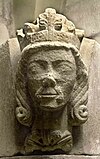 | Valdemar Valdemar Birgersson |  | |||
 | Magnus III "Barnlock" Magnus (Ladulås) Birgersson |  | |||
 | Birger Birger Magnusson | ||||
 | Magnus IV Magnus Eriksson | ||||
 | Eric XII[b] Erik Magnusson | ||||
 | Håkan II Håkan Magnusson |  |
| Portrait | Name | Arms | Reign | Succession | Life details |
|---|---|---|---|---|---|
 | Albert of Mecklenburg Albrekt av Mecklenburg |  |
| Portrait | Name | Arms | Reign | Succession | Life details |
|---|---|---|---|---|---|
 | Margaret Margareta Valdemarsdotter |  | |||
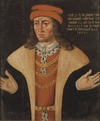 | Eric XIII[b] of Pomerania Erik av Pommern |  | |||
| Regency of Charles Knutsson Bonde (later king Charles VIII; October 1438 – Autumn 1440) | |||||
 | Christopher of Bavaria Kristofer av Bayern |  | |||
| Regency of Bengt Jönsson Oxenstierna and Nils Jönsson Oxenstierna (January – 20 June 1448) | |||||
 | Charles VIII[b] Karl Knutsson Bonde |  | 20 June 1448 – 24 February 1457 (8 years, 8 months and 4 days) (first reign) | ||
| First regency of Jöns Bengtsson Oxenstierna and Erik Axelsson Tott (March – 23 June 1457) | |||||
 | Christian I Kristian I |  | 23 June 1457 – 23 June 1464 (7 years) | ||
 | Charles VIII[b] Karl Knutsson Bonde |  | 9 August 1464 – 30 January 1465 (5 months and 21 days) (second reign) | ||
| Regency of Kettil Karlsson Vasa (26 December 1464 – 11 August 1465) | |||||
| Second regency of Jöns Bengtsson Oxenstierna (11 August 1465 – 18 October 1466) | |||||
| Second regency of Erik Axelsson Tott (18 October 1466 – 12 November 1467) | |||||
 | Charles VIII[b] Karl Knutsson Bonde |  | 12 November 1467 – 15 May 1470 (2 years, 6 months and 3 days) (third reign) | ||
| First regency of Sten Sture the Elder (16 May 1470 – 6 October 1497) | |||||
 | John II Johan II / Hans |  | 6 October 1497 – 1 August 1501 (3 years, 9 months and 26 days) | ||
| Second regency of Sten Sture the Elder (12 November 1501 – 14 December 1503) | |||||
| Regency of Svante Nilsson (21 January 1504 – 31 December 1511/2 January 1512) | |||||
| Regency of Eric Trolle (January – 23 July 1512) | |||||
| Regency of Sten Sture the Younger (23 July 1512 – 3 February 1520) | |||||
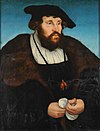 | Christian II "the Tyrant" Kristian II |  | 1 November 1520 – 23 August 1521 (9 months and 22 days) | ||
| Regency of Gustav Vasa (later king Gustav I; 23 August 1521 – 6 June 1523) | |||||
| Portrait | Name | Arms | Reign[i] | Succession | Life details | Cypher |
|---|---|---|---|---|---|---|
 | Gustav I Gustav Vasa |  [j] | 6 June 1523 – 29 September 1560 (37 years, 3 months and 23 days) | Previously regent, elected king after the Swedish War of Liberation[k] | 12 May 1496 – 29 September 1560 (aged 64) Married to Catherine of Saxe-Lauenburg (1531–1535, 1 child), then Margaret Leijonhufvud (1536–1551, 10 children) and then Catherine Stenbock (1552–1560, childless)[40] | — [l] |
 | Eric XIV Erik XIV | 29 September 1560 – 29 September 1568 (8 years) | Son of Gustav I | 13 December 1533 – 26 February 1577 (aged 43) Married to Karin Månsdotter (5 children). Deposed and later poisoned, perhaps by his brother John III.[40][42] | ||
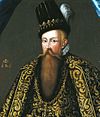 | John III Johan III |  [m] | 29 September 1568 – 17 November 1592 (24 years, 1 month and 19 days) | Son of Gustav I | 21 December 1537 – 17 November 1592 (aged 54) Married to Catherine Jagiellon (1562–1583, 3 children) and then Gunilla Bielke (1585–1592, 1 child)[40] | |
 | Sigismund | 17 November 1592 – 24 July 1599 (6 years, 8 months and 7 days) | Son of John III | 20 June 1566 – 30 April 1632 (aged 65) Married to Anne of Austria (1592–1598, 5 children) and then to Constance of Austria (1605–1631, 7 children). Deposed after the war against Sigismund. Also king of Poland 1587–1632.[40][43] | ||
| Regency of Duke Charles (later king Charles IX; 24 July 1599 – 22 March 1604) | ||||||
 | Charles IX Karl IX |  | 22 March 1604 – 30 October 1611 (7 years, 7 months and 8 days) | Son of Gustav I, proclaimed king after serving as regent for five years | 4 October 1550 – 30 October 1611 (aged 61) Married to Maria of the Palatinate (1579–1589, 6 children) and then Christina of Holstein-Gottorp (1592–1611, 4 children)[40][44] | — [n] |
 | Gustav II Adolf (Gustavus Adolphus) | 30 October 1611 – 16 November 1632 (21 years and 17 days) | Son of Charles IX | 9 December 1594 – 16 November 1632 (aged 37) Married to Maria Eleonora of Brandenburg (2 children). Killed at the Battle of Lützen in 1632.[40] | ||
 | Christina Kristina | 16 November 1632 – 6 June 1654 (21 years, 6 months and 21 days) | Daughter of Gustav II Adolf | 8 December 1626 – 19 April 1689 (aged 62) Unmarried and childless. Abdicated and retired to Rome.[40] | ||
| Portrait | Name | Arms | Reign[i] | Succession | Life details | Cypher |
|---|---|---|---|---|---|---|
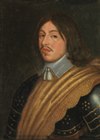 | Charles X Gustav Karl X Gustav |  | 6 June 1654 – 23 February 1660 (5 years, 8 months and 17 days) | Son of Catherine of Sweden, a daughter of Charles IX | 18 November 1622 – 23 February 1660 (aged 37) Married to Hedwig Eleonora of Holstein-Gottorp (1 child)[40] | |
 | Charles XI Karl XI | 23 February 1660 – 15 April 1697 (37 years, 1 month and 23 days) | Son of Charles X Gustav | 4 December 1655 – 15 April 1697 (aged 41) Married to Ulrika Eleonora of Denmark (7 children)[40] | ||
 | Charles XII Karl XII | 15 April 1697 – 11 December 1718 (21 years, 7 months and 26 days) | Son of Charles XI | 27 June 1682 – 11 December 1718 (aged 36) Unmarried and childless. Killed in battle against Denmark–Norway during the siege of Fredriksten in 1718.[45] | ||
 | Ulrika Eleonora | 23 January 1719 – 26 March 1720 (1 year, 2 months and 3 days) | Daughter of Charles XI, elected as successor of her childless brother | 2 February 1688 – 5 December 1741 (aged 53) Married to Frederick of Hesse-Cassel (childless), whom she abdicated in favor of in 1720; thereafter consort until her death.[45] |
| Portrait | Name | Arms | Reign[i] | Succession | Life details | Cypher |
|---|---|---|---|---|---|---|
 | Frederick I Fredrik I |  | 26 March 1720 – 5 April 1751 (31 years and 10 days) | Husband and designated successor of Ulrika Eleonora | 8 May 1676 – 5 April 1751 (aged 74) Married to Luise Dorothea of Prussia (1700–1705, childless) and then Ulrika Eleonora (1715–1741, childless)[45] |
| Portrait | Name | Arms | Reign[i] | Succession | Life details | Cypher |
|---|---|---|---|---|---|---|
 | Adolf Frederick Adolf Fredrik |  | 5 April 1751 – 12 February 1771 (19 years, 10 months and 7 days) | Great-great-great-grandson of Charles IX,[o] elected as heir to the throne in 1743. Succeeded as king upon Frederick I's death. | 14 May 1710 – 12 February 1771 (aged 60) Married to Louisa Ulrika of Prussia (4 children). Originally Prince-Bishop of Lübeck (1727–1750).[45] | |
 | Gustav III |  [p] | 12 February 1771 – 29 March 1792 (21 years, 1 month and 17 days) | Son of Adolf Frederick | 24 January 1746 – 29 March 1792 (aged 46) Married to Sophia Magdalena of Denmark (2 children). Assassinated in 1792.[45] | |
 | Gustav IV Adolf |  | 29 March 1792 – 29 March 1809 (17 years) | Son of Gustav III | 1 November 1778 – 7 February 1837 (aged 58) Married to Frederica of Baden (5 children). Deposed after defeat in the Finnish War; died in exile in Switzerland.[45][q] | |
| Regency of Duke Charles (later king Charles XIII; 29 March – 3 June 1809) | ||||||
 | Charles XIII Karl XIII |  | 3 June 1809 – 5 February 1818 (8 years, 8 months and 2 days) | Son of Adolf Frederick, elected king by the Riksdag of the Estates after a brief tenure as regent | 7 October 1748 – 5 February 1818 (aged 69) Married to Hedvig Elisabeth Charlotte of Holstein-Gottorp (2 children, died in infancy). Also king of Norway (from 1814).[45] | |
| Portrait | Name | Arms | Reign | Succession | Life details | Cypher |
|---|---|---|---|---|---|---|
 | Charles XIV John Karl XIV Johan |  | 5 February 1818 – 8 March 1844 (26 years, 1 month and 3 days) | Elected in 1810 as heir to the childless Charles XIII by the Riksdag of the Estates and then adopted by Charles XIII; succeeded him upon his death[r] | 26 January 1763 – 8 March 1844 (aged 81) Married to Désirée Clary (1 child). Originally a French general, then Marshal of the Empire and Prince of Pontecorvo (1806–1810).[45] | |
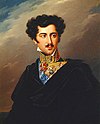 | Oscar I |  | 8 March 1844 – 8 July 1859 (15 years and 4 months) | Son of Charles XIV John | 4 July 1799 – 8 July 1859 (aged 60) Married to Josephine of Leuchtenberg (5 children)[45] | |
 | Charles XV Karl XV | 8 July 1859 – 18 September 1872 (13 years, 2 months and 10 days) | Son of Oscar I | 3 May 1826 – 18 September 1872 (aged 46) Married to Louise of the Netherlands (2 children). First monarch of the House of Bernadotte to be born in Sweden.[50] | ||
 | Oscar II |  | 18 September 1872 – 8 December 1907 (35 years, 2 months and 20 days) | Son of Oscar I | 21 January 1829 – 8 December 1907 (aged 78) Married to Sophia of Nassau (4 children). Last Swedish king to also be king of Norway (until 1905).[51] | |
 | Gustaf V |  | 8 December 1907 – 29 October 1950 (42 years, 10 months and 21 days) | Son of Oscar II | 16 June 1858 – 29 October 1950 (aged 92) Married to Victoria of Baden (3 children)[51] | |
 | Gustaf VI Adolf | 29 October 1950 – 15 September 1973 (22 years, 10 months and 17 days) | Son of Gustaf V[s] | 11 November 1882 – 15 September 1973 (aged 90) Married to Margaret of Connaught (1905–1920, 5 children) and then Louise Mountbatten (1923–1965, 1 stillborn child)[51] | ||
 | Carl XVI Gustaf |  | 15 September 1973 – present (50 years, 8 months and 11 days) | Grandson of Gustaf VI Adolf | Born 30 April 1946 (aged 78) Married to Silvia Sommerlath (3 children). The longest reigning monarch in Swedish history.[51][52] |